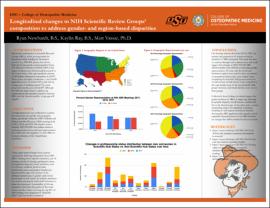| dc.contributor.author | Newhardt, Ryan | |
| dc.contributor.author | Ray, Kaylin | |
| dc.contributor.author | Vassar, Matt | |
| dc.date.accessioned | 2023-09-12T16:45:04Z | |
| dc.date.available | 2023-09-12T16:45:04Z | |
| dc.date.issued | 2022-02-18 | |
| dc.identifier | ouhd_Newhardt_longitudinalchangestoNIH_2022 | |
| dc.identifier.citation | Newhardt, R., Ray, K., & Vassar, M. (2022, February 18). Longitudinal changes to NIH Scientific Review Groups’ composition to address gender- and region-based disparities. Poster presented at Research Days at Oklahoma State University Center for Health Sciences, Tulsa, Ok. | |
| dc.identifier.uri | https://hdl.handle.net/11244/339538 | |
| dc.description.abstract | Historically, participation in Scientific Research Groups, which are responsible for delegating federal funding for biomedical research (e.g. NIH R01 grants), has shown disproportionate gender and geographic biases. Overrepresentation by men and citizens from urban centers has led to inequitable prioritization of research aims and project funding. Recently, public sentimenthas had some success with identifying and addressing social disparities in academic environments. A longitudinal study was conducted to examine the disproportionate gender and geographic biases, specifically within the NIH Arthritis and Skeletal and Skin Diseases (AMS) meetings held in 2011, 2016, and 2021. Using a pilot-tested Google Form, authors extracted the following information from NIH Scientific Review Group (SRG) Rosters: specific institution of health, year of meeting, month of meeting, participant’s name, post-graduate degree(s), home institution, state of residence, academic position/rank, membership status, and gender. Gender was determined through web searches of the affiliated institution(s); if gender could not be determined via web search, the website genderize.io was used by entering the individual’s forename to make the conclusion. A probability of 0.6 was required to determine the gender of the study section member. In earlier study sections women were less represented compared to men. In 2011, 67% (n=54) of members represented were men, while 33% (n=26) were women; 2016 had 56% (n=48) of members as men and 44% (n=37) as women; 2021 plateaued with 50% (n=52) of both men and women being represented equally. Regarding geographical representation, percentages remained much more stagnant for each region over the years. In 2011, the Northeast had the most members represented at 29% (n=23); the Midwest and Southeast both equaled 25% (n=20); the West was 17% (n=14), followed by the Southwest at 4% (n=3). In 2016, the Northeast saw an increase in represented members at 31% (n=26); the percentage representing Southeast also increased to 29% (n=25); the Midwest was at 19% (n=16); the West was at 18% (n=15); the Southwest remained low at 3% (n=3) representation. | |
| dc.description.abstract | Lastly, 2021 results showed that the Northeast remained most represented at 41% (n=42); the Southeast was represented at 19% (n=20); both the West and Midwest were represented at 18%(n=19); the Southwest remained in the lowest represented region at 4% (n=4). Additionally, comparing the top quintile of states receiving NIH funding to the bottom four quintile demonstrated a lower rate of inclusion of women over time in states receiving low NIH fundingcompared to their first quintile counterparts. Ultimately, our results suggest that NIH has done a better job over time to select women to serve on NIH AMS study sections. | |
| dc.format | application/pdf | |
| dc.language | en_US | |
| dc.publisher | Oklahoma State University Center for Health Sciences | |
| dc.rights | The author(s) retain the copyright or have the right to deposit the item giving the Oklahoma State University Library a limited, non-exclusive right to share this material in its institutional repository. Contact Digital Resources and Discovery Services at lib-dls@okstate.edu or 405-744-9161 for the permission policy on the use, reproduction or distribution of this material. | |
| dc.title | Longitudinal changes to NIH Scientific Review Groups’ composition to address gender- and region-based disparities | |
| osu.filename | ouhd_Newhardt_longitudinalchangestoNIH_2022.pdf | |
| dc.type.genre | Presentation | |
| dc.type.material | Text | |
| dc.subject.keywords | gender | |
| dc.subject.keywords | funding | |
| dc.subject.keywords | grants | |
| dc.subject.keywords | NIH AMS section | |
| dc.subject.keywords | pilot-tested | |
